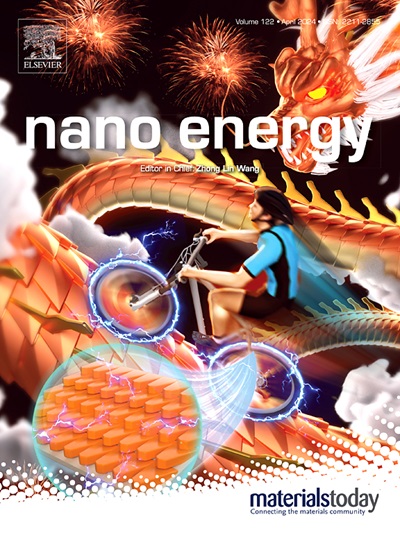Water wave energy-harvesting accordion structure triboelectric nanogenerators for self-driven corrosion protection
IF 17.1
1区 材料科学
Q1 CHEMISTRY, PHYSICAL
引用次数: 0
Abstract
Triboelectric nanogenerators (TENGs) have become a promising energy harvesting technology due to robustness, low cost and scalability. In this work, a novel oscillating water energy harvesting device (OS-TENG) inspired by the accordion structure is reported. The triboelectric material with interlayer structure is constructed by electrospinning technology, and the spatial efficiency of device is enhanced by stacking U-sheet structure and array accordion-like power module, enabling the conversion of mechanical energy into electrical energy. At the same time, the operational mechanism of device is comprehensively analyzed, and the parameters such as the angle of elastomer are systematically optimized. Under a condition of 3 Hz, the OS-TENG achieves a current output of 70 μA and a power density of 124 mW/m², while maintaining exceptional electrical output stability over a period of 10 days. Owing to superior performance, the OS-TENG is capable of powering LED lights, thermometers and wireless signal transmission systems. More importantly, it is also applicable to electrochemical processes including water electrolysis for hydrogen production and cathodic protection of metals, the potential of 304SS is decreased 250 mV, which shows obvious corrosion protection effect. This work provides a promising approach for large-scale water wave energy harvesting and self-driven electrochemistry without external power sources.

用于自驱动防腐蚀的水波能量收集手风琴结构摩擦纳米发电机
摩擦电纳米发电机(TENGs)因其鲁棒性、低成本和可扩展性而成为一种很有前途的能量收集技术。本文报道了一种受手风琴结构启发的新型振荡水能收集装置(OS-TENG)。采用静电纺丝技术构建层间结构的摩擦电材料,通过u片结构的堆叠和阵列手风琴式功率模块的叠加,提高器件的空间效率,实现机械能向电能的转换。同时,对装置的工作机理进行了全面分析,并对弹性体角度等参数进行了系统优化。在3hz条件下,OS-TENG的输出电流为70 μA,功率密度为124 mW/m²,同时在10天内保持出色的电输出稳定性。由于性能优越,OS-TENG能够为LED灯、温度计和无线信号传输系统供电。更重要的是,它也适用于电解制氢和金属阴极保护等电化学过程,304SS电位降低250 mV,具有明显的防腐效果。该研究为大规模水波能量收集和无外部电源的自驱动电化学提供了一种有前途的方法。
本文章由计算机程序翻译,如有差异,请以英文原文为准。
求助全文
约1分钟内获得全文
求助全文
来源期刊

Nano Energy
CHEMISTRY, PHYSICAL-NANOSCIENCE & NANOTECHNOLOGY
CiteScore
30.30
自引率
7.40%
发文量
1207
审稿时长
23 days
期刊介绍:
Nano Energy is a multidisciplinary, rapid-publication forum of original peer-reviewed contributions on the science and engineering of nanomaterials and nanodevices used in all forms of energy harvesting, conversion, storage, utilization and policy. Through its mixture of articles, reviews, communications, research news, and information on key developments, Nano Energy provides a comprehensive coverage of this exciting and dynamic field which joins nanoscience and nanotechnology with energy science. The journal is relevant to all those who are interested in nanomaterials solutions to the energy problem.
Nano Energy publishes original experimental and theoretical research on all aspects of energy-related research which utilizes nanomaterials and nanotechnology. Manuscripts of four types are considered: review articles which inform readers of the latest research and advances in energy science; rapid communications which feature exciting research breakthroughs in the field; full-length articles which report comprehensive research developments; and news and opinions which comment on topical issues or express views on the developments in related fields.
 求助内容:
求助内容: 应助结果提醒方式:
应助结果提醒方式:


